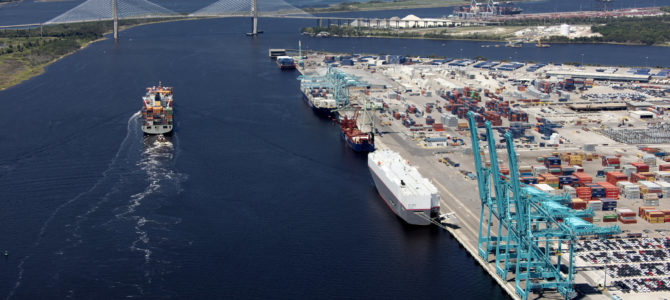
British international trade secretary Liz Truss recently announced the United Kingdom will apply to join the Comprehensive and Progressive Agreement for Trans-Pacific Partnership. To date, the United States is the only country in the world to have dissented from what is now the world’s largest trade bloc. For the sake of American prosperity, Joe Biden should seize the opportunity and push for the United States to join the new CPTPP also.
Just four days after his inauguration, then-President Donald Trump fulfilled a campaign promise by signing an executive order withdrawing from the Trans-Pacific Partnership, the forerunner to the CPTPP. Trump described the trade pact as a “potential disaster for our country,” alleging that Barack Obama’s enthusiasm for it was foolish and that the pact would have sold out the American manufacturing industry.
Around the time of Trump’s withdrawal, there appeared to be a cross-party consensus against it, with even Hillary Clinton voicing opposition to the TPP despite her instrumental role in creating it. That stance set the United States apart from the rest of the world. Signatories already included Australia, Canada, Chile, Japan, Mexico, New Zealand, Peru, Singapore, and others.
While Trump’s “America first” mantra may have been powerful enough to suck in Democrats, the facts never bore it out. Joining the TPP would have bolstered the American working classes by opening them to enormous new — and fast-growing — markets in Asia, previously inaccessible because of tariffs and other trade barriers.
Empowering American Manufacturers
The price of American-produced poultry is today 40 percent more expensive because of tariffs, and American-made cars cost 59 percent more than they would otherwise.
The graver result of Trump’s embrace of protectionism is that American manufacturers can’t compete on a global level. Conversely, entering an international trade community in which those barriers don’t exist would wipe out those import taxes, providing American companies with billions of brand new, wealthy potential consumers.
American industry’s reach should not be confined to American borders. There is no reason American-based companies shouldn’t be competitive in Asia. Lowering trade barriers would open American industry to a whole new continent of eager customers, which is why signing up to the TPP would boost jobs and swell wages.
If only U.S. manufacturers operated to their full potential in these booming markets, Asian countries could easily be swimming in “Made in America” labels and funneling a thundering torrent of new money directly into the pockets of working-class Americans. Unfortunately for them, in 2016, it was off the table.
To Counter China, America Needs Trade Influence
Fast-forward to 2021 and Biden finds himself at a crossroads on America’s economic relationship with the rest of the world. As well as a vehicle for lighting a fire under economic growth to everyone’s benefit, the CPTPP is fast emerging as the Western world’s answer to the soft power of the Chinese Communist Party, which appears to have peaked. Even in the United Kingdom, which was supposed to be bogged down in post-Brexit trade isolation and is nowhere near the Pacific, the government seems elated to be a part of it.
Inconveniently for President Biden, however, the United States is now outside the club. If, indeed, the United States is to keep up with the rest of the world as it enters post-pandemic economic recovery, then Biden has a great deal of work to do to mend those relationships and rebuild American standing on the world stage.
Perhaps more importantly, the United States must be in a position of influence to retain its status as the undisputed leader of the global coalition to undermine the immense influence of the Chinese communist dictatorial regime.
Escaping From China’s Grasp
The current members of the CPTPP are soon to be joined by the United Kingdom, closely followed — if reports are to be believed — by South Korea, the Philippines, Taiwan, Colombia, and even the European Union. Already, the CPTPP is becoming a who’s who of non-Chinese economic prowess.
Free trade has brought together this almighty smorgasbord of countries under a common banner, but China’s actions sealed the deal. 2020 was the year the world woke up to the terrifying extent of Beijing’s power. From the suppression of democracy in Hong Kong to the constant violation of Taiwanese sovereignty, from the genocide of the Uighur Muslims in Xinjiang to the catastrophic coronavirus coverup, it is now inescapably clear that the CCP’s actions have cost countless millions of lives.
Finally, the rest of the world is joining to construct an economic norm that is not reliant on China. How? By signing free trade agreements with each other, opening markets to one another, and pooling resources, the world escapes from under Beijing’s thumb.
It’s already working. Last May, Chinese state media reported the country was “sending a powerful signal” of its intention to join the CPTPP. The government statement said “China is willing to consider joining” the new trade bloc — even though they haven’t been invited. The CCP feels its grip on the world slipping away and is beginning to panic.
The CPTPP is a means to an end. The ultimate goal is maximizing free trade. On a quite fundamental level, all those who believe in the power of the free market to boost wages, create jobs, and lift people out of poverty en masse must now put all their weight behind building a new way of doing things, creating conditions in which we can trade with each other freely. That is true irrespective of the way China behaves.
Keeping Our Eyes On the Long Game
Last year’s pandemic brought home the urgency of abandoning protectionism in infinitely harrowing ways. Take, for instance, the tragic state of affairs in American hospitals at the beginning of the crisis, in March of last year.
Motivated by a desire to “reduce foreign dependency on medicines,” the Trump White House set out to relocate medical supply chains from abroad to within American borders. As well-intentioned as that might have been, during an earth-shattering health crisis it was myopic in the extreme.
Perhaps predictably, cutting the United States off from foreign suppliers of vital goods when demand for those goods was extremely high soon resulted in widespread domestic shortages. We live in a globalized world in which different countries specialize in making different things. The United States never had the momentum to build up the manufacturing capacity it would have needed to supply itself with ventilators and personal protective equipment (PPE) for health-care workers.
Short-sighted trade nationalism exacerbated an already disastrous situation. Building new supply chains from scratch is slow and costly at the best of times, let alone amid an unprecedented global pandemic. When American lives are on the line, it is difficult to justify insisting on only buying critical products from domestic manufacturers — even when the alternative is buying them from China.
Trump was far from the only world leader to make that mistake. Even President Emmanuel Macron of France, once the crown prince of globalism, at one point announced his intention to bring supply chains within national borders. The difference, though, is that Trump’s “America first” outlook predated the pandemic and was always founded on flimsy reasoning and a lack of empirical, proven reasoning to back it up.
For instance, Trump regularly pointed out the billion-dollar trade deficits the United States carried with other countries, citing this as evidence of foreign exploitation of American workers. That is simply not how trade works.
I have a substantial “trade deficit” with my local diner, but I keep going back there and spending more money. Why? Because I’m not oppressed simply because currency is exclusively flowing in one direction and (tasty) goods are exclusively flowing in the other. An economic relationship does not have to involve an equal amount of money traveling in each direction for it to be mutually beneficial.
For the sake of American workers, it’s high time to learn the lessons of recent years and reap the rewards of free trade. In the end, the free movement of goods benefits everyone.









